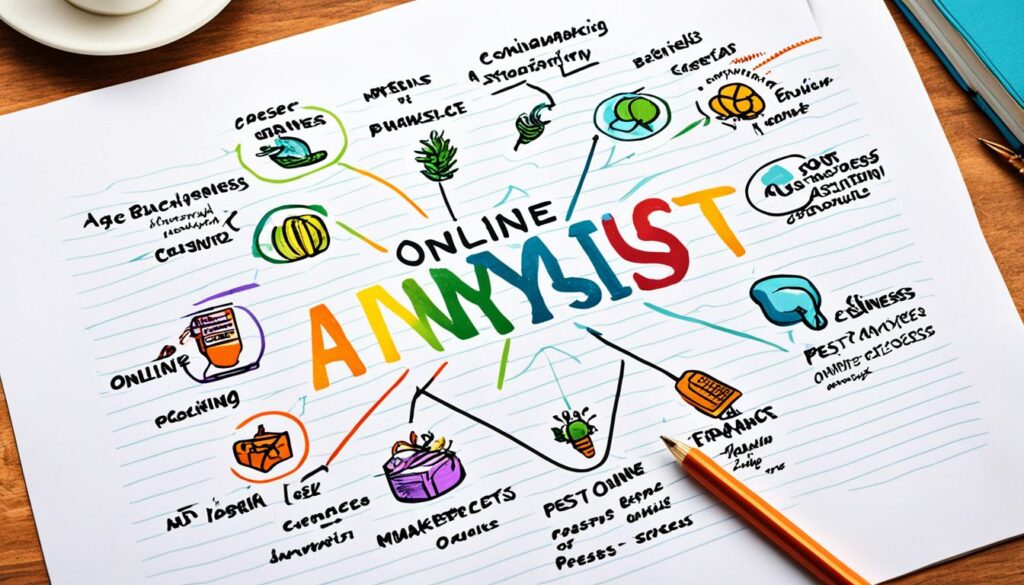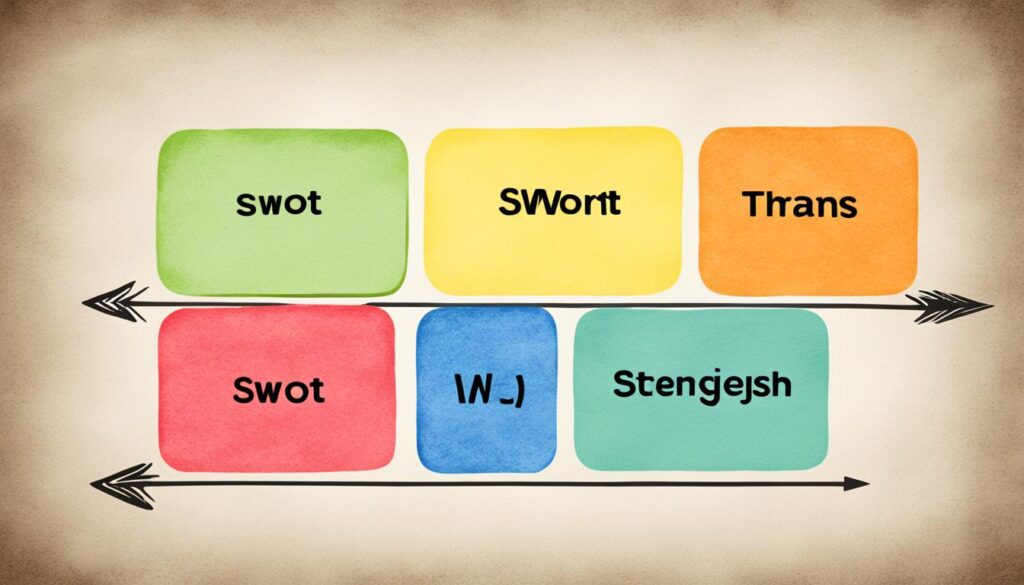Welcome to the essential guide to online business marketing! In today’s digital world, having a powerful online presence is key. This helps your business grow and succeed.
Everyone is connected online today, both consumers and businesses. That’s why it’s vital to use effective strategies to reach and engage your audience.
This guide will give you proven strategies for online marketing. You’ll get valuable tips for small business marketing and practical digital marketing tutorials. It’s perfect whether you’re just starting or improving your existing efforts.
Here, we’ll dive into everything from SEO to social media marketing, and email marketing best practices. You’ll learn all the key parts of a great online business marketing plan.
By the end of this guide, you’ll have all you need. You’ll be ready to create a strong marketing strategy. This will drive your business growth and help you achieve your goals.

Key Takeaways:
- Learn effective strategies for online marketing
- Discover tips for small business marketing
- Explore digital marketing tutorials and resources
- Optimize your online business with SEO techniques
- Harness the power of social media marketing
Understanding Marketing Strategy and Tactics: A Comprehensive Overview.
A marketing strategy outlines the plan to reach marketing goals. It looks at what makes your business strong or weak. Then, it plans ways to succeed. On the other hand, marketing tactics are the steps taken to make the strategy work. They help achieve goals quickly.
For small businesses, a clear marketing strategy is key. It gives direction and helps use resources well. Especially, a digital marketing strategy focuses on using the internet. It aims to attract more people and grow the business.
It’s important for any business to understand both marketing strategy and tactics well. This knowledge is essential for success online. Let’s look closer at what each means:
Marketing Strategy
A marketing strategy is your guide for marketing actions. It aims for long-term targets. It considers who you want to reach, current trends, and your competition. This helps place your brand well in the market.
Important points of a marketing strategy include:
- Objective-driven: It’s all about reaching goals like more awareness or more website visitors.
- Segmentation and targeting: You identify and understand your audience. Then, you adapt your marketing to talk directly to them.
- Positioning: This strategy makes your brand stand out. It shows why you’re different and what’s special about what you offer.
- Long-term perspective: It’s a plan for your marketing actions. It considers both the immediate steps and future goals.
Marketing Tactics
Marketing tactics are specific steps taken to follow the marketing strategy. They focus on achieving quick results. These actions help your marketing plan succeed.
Important points of marketing tactics include:
- Tangible and measurable: These actions could be social media ads, email campaigns, or improving your website.
- Short-term focus: Tactics aim for quick results. They support the bigger marketing plan.
- Targeted approach: Tactics focus on reaching certain groups effectively. They aim for clear goals.
- Data-driven: You can change and improve tactics based on what you learn from your results.
Knowing the difference between strategy and tactics is vital for good digital marketing planning. If your tactics match your strategy, you can create a strong marketing plan. This helps your small business grow and succeed.
Building a Solid Marketing Strategy for Your Online Business.
Creating a successful marketing strategy is key for your online business growth and success. It helps you connect with your audience well and make the most of your efforts. This guide walks you through crafting a strategy just for your online business.
Understanding Your Target Audience and Creating Buyer Personas
Knowing your audience is the first key step. By understanding their details, likes, and actions, you can create targeted campaigns. Making detailed buyer personas lets you picture and know your ideal customers better. These personas are fictional versions of your audience, shaping your efforts to meet their needs.
With your personas made, they guide your strategy decisions. They ensure your messages, content, and channels are well-matched to engage your audience.
Identification of Goals and Objectives
Setting SMART goals and objectives is vital for a fruitful strategy. These goals track your progress and measure your marketing’s success.
Your goals might be to get more website visitors, generate leads, increase sales online, or boost your brand’s visibility. With clear goals, you can direct your marketing actions and tools to achieve these aims.
Selection of Appropriate Digital Marketing Tools
The digital realm offers many tools and platforms for marketing. Picking the right tools that fit your goals is essential.
Look into tools for handling social media, making and sharing content, optimizing for search engines, automating emails, managing customer relationships, and analyzing data. These tools simplify your marketing, enhance efficiency, and give insight into your strategy’s impact.
Evaluation of Existing Digital Channels and Assets
Assessing your current digital channels and assets is crucial. This helps you identify what’s working well and should be part of your strategy.
If your blog gets a lot of organic traffic or you have a strong social media presence, use these to grow further. Likewise, spotting any low-performing channels or assets lets you decide how to improve or possibly drop them. This evaluation is a step towards a strong marketing strategy for your online business.
By following these steps, you tailor a solid marketing strategy that fits your audience, goals, and resources. Regularly update your strategy to reflect changes in the market, consumer behavior, and your business aims. This ensures your online business continues to succeed and expand.

Conducting a PEST Analysis for Your Marketing Strategy.
A PEST analysis helps evaluate external factors affecting your marketing. It aids in crafting an effective strategy for your online business. By considering these elements, you can drive your marketing efforts to success.
But what exactly is a PEST analysis?
A PEST analysis looks into four major areas impacting your marketing:
- Political: This examines how government actions and stability influence marketing. It looks at laws, trade policies, and tax changes that could affect your business.
- Economic: This part studies the economy’s state, including inflation and consumer spending. Understanding these helps you adjust your marketing strategies to match economic changes.
- Social: Social factors include cultural trends and consumer behavior. Analyzing these helps you connect better with your audience by tailoring your marketing approach.
- Technological: This focuses on tech advancements that could alter your marketing. It covers tech changes, digital trends, and new tools or platforms.
Conducting a PEST analysis solidifies your marketing strategy by aligning it with outside factors. Let’s examine how each factor affects marketing:
“New government regulations may push online businesses for stricter data protection, changing their marketing strategies.”
“An economic downturn may lead to reduced consumer spending. Small businesses might need to revise their marketing messages and promotions.”
“Trends towards sustainability could encourage businesses to include green practices in their marketing.”
“Tech advances like artificial intelligence may help businesses improve marketing personalization and targeting.”
Through a PEST analysis, you uncover insights on external factors influencing your marketing. This analysis guides your decisions, helping you adapt to business environment changes.
| Factor | Impact |
|---|---|
| Political | Government regulations, trade policies, taxation |
| Economic | Inflation, interest rates, consumer purchasing power |
| Social | Cultural trends, demographics, consumer behavior |
| Technological | Advancements, digital trends, emerging platforms |
By analyzing political, economic, social, and technological factors, you create a marketing strategy that adapts to your goals and external changes.

SWOT Analysis: Evaluating Your Strengths, Weaknesses, Opportunities, and Threats.
A SWOT analysis is a powerful tool for your business. It looks at both internal and external factors. Through this, you learn how to shape your marketing strategy.
Strengths: Think of these as your business’s superpowers. This could be anything from unique offerings to a well-known brand or skilled team. Using your strengths helps pull in more customers.
Weaknesses: These are areas where you’re not as strong. Maybe you’re short on resources or lack some know-how. Recognizing weaknesses shows you where to improve.
“A SWOT analysis empowers businesses to capitalize on opportunities and mitigate potential threats.”
Opportunities: Think of these as chances for your business to grow. These could stem from market trends or new customer needs. Spotting opportunities lets you lead the pack.
Threats: These are external challenges that could slow you down. They might be fierce competitors or big market shifts. Knowing these threats helps you plan against them.
Doing a SWOT analysis shows the full picture of your business. It identifies your strong points, places to grow, and what the outside world holds. With this knowledge, you can create a solid marketing plan. This will help you reach your goals and win big.

SWOT Analysis Example:
| Strengths | Strong brand recognition and customer loyalty |
|---|---|
| Weaknesses | Limited online presence and outdated website |
| Opportunities | Expanding into international markets |
| Threats | Increased competition from new entrants |
Creating a Digital Marketing Campaign: From Planning to Execution.
A digital marketing campaign is crucial for your overall strategy. It targets specific goals to grow your online business. By planning carefully, you can create a campaign that reaches and engages your audience well.
Let’s look at how to plan and execute a digital marketing campaign.
1. Set Clear Goals
The first thing to do is define clear, measurable goals. These goals are the base of your campaign and guide your choices. They can range from increasing brand awareness to boosting sales. It’s vital to have specific, achievable goals.
2. Identify Target Audiences
Knowing your audience is key for a successful campaign. Do research and gather data to learn who they are. This helps you create messages that really speak to them.
You can then choose the best ways to reach and engage them.
3. Select Appropriate Marketing Channels
After finding your audience, pick the right marketing channels for them. You might use social media, search ads, email, or content marketing. Each channel has unique benefits for promoting your business and connecting with people.
4. Craft Compelling Content
Good content is central to any campaign. Make interesting content that matters to your audience. This could be blog posts, videos, infographics, or social media updates. Your content should either teach, entertain, or inspire your audience in line with your goals.
5. Implement a Multi-channel Approach
For more reach and impact, use many marketing channels. This gets your message to more people across different places. A multi-channel approach boosts chances to engage with your audience everywhere online.
When your campaign is up, keep an eye on how it’s doing. Look at the data, track success, and adjust as needed. This helps improve your campaign and future efforts.

Planning and executing a digital marketing campaign is strategic. It needs careful thought and action. Following these steps helps you promote your business online, get new customers, and grow.
Maximizing the Impact of Content Marketing in Your Strategy.
Content marketing is a key part of a winning digital marketing strategy. It focuses on making and sharing valuable, relevant content to draw in and engage your audience. Knowing how critical content marketing is and using effective methods can boost your online marketing.
Selecting the Right Content Formats
Choosing the right formats for your content is vital. Whether it’s blog posts, videos, infographics, or podcasts, each type has its own way of delivering your message. Think about what your audience likes and pick the most fitting formats for your content.
Creating Compelling and Valuable Content
To succeed in content marketing, make high-quality content that resonates. Think from your audience’s perspective and create content that solves their problems, teaches them, or entertains. Use storytelling, visuals, and interesting language to grab their attention and make an impact.
Utilizing SEO Techniques
Making your content search engine-friendly is essential for increasing its reach and visibility. Include relevant keywords naturally, optimize meta tags and headings, and make sure your content is easy to read and share. Effective SEO can make your content more visible and bring more organic traffic to your site.
Distributing Content Through Various Channels
Don’t just share your content on one platform. Use many channels to reach more people. Post your content on social media, use email marketing, work with influencers, and try guest blogging. Spreading your content across different channels helps attract more potential customers.
Measuring Content Marketing Performance
It’s important to check how well your content marketing is doing. Look at website traffic, engagement rates, social media shares, and conversions. Use analytics tools to see which content works best and where you can improve. By evaluating and tweaking your strategy based on data, you can keep getting better results.

| Content Marketing Metrics | Definition | Importance |
|---|---|---|
| Website Traffic | The number of visitors your website receives. | Indicates the reach and effectiveness of your content in driving traffic to your website. |
| Engagement Rates | The level of interaction and involvement your audience has with your content. | Shows how well your content resonates with your audience and encourages further engagement. |
| Social Media Shares | The number of times your content is shared on social media platforms. | Reflects the level of interest and engagement your content generates within your audience and expands your reach. |
| Conversions | The number of desired actions taken by users on your website. | Measures the effectiveness of your content in driving desired outcomes, such as sales or lead generation. |
Leveraging Social Media for Effective Marketing.
Social media marketing is changing how businesses reach people. With lots of users on various platforms, it opens big chances for online marketing. Businesses can make their brand more known, talk to customers, and get more website visitors by using social media right.
To do well on social media, create content that people want to share. This includes blog posts, videos, or infographics that offer value. Content that clicks with your audience boosts engagement, reach, and sales. Use keywords that matter to your business for better SEO and more visibility.
“Social media is not just about blasting promotional content. It’s about creating a conversation and building relationships with your audience.” – Mark Johnson, Social Media Strategist
Talking to your audience is key on social media. Quickly and truly answer comments, messages, and reviews. To get people to create content about your brand, run contests or use hashtags. This encourages sharing their experiences.
It’s vital to check how your social media is doing. Look at reach, engagement, click-throughs, and conversion rates. Use analytics tools to see these metrics. This helps you understand what’s working for your business.
Staying Up to Date with Social Media Trends
Social media trends change all the time. To stay ahead, watch out for new platforms and features your audience might like. If you target younger people, think about using TikTok. Keep up with industry news, join webinars, and take part in online groups to stay current.
Social Media Platforms and Best Practices
Each social media platform has its own audience and best ways to use it. Below are some tips for well-known platforms:
Facebook:
- Create a business page and fill it with important info, visuals, and a call-to-action.
- Post both original and curated content that fits your brand.
- Use Facebook to target specific groups of people.
- Try Facebook Ads to reach even more people.
Instagram:
- Make your brand look good with a consistent visual style.
- Use hashtags to be more visible.
- Connect with your audience using Stories, Reels, and IGTV.
- Work with influencers who match your brand and audience.
Twitter:
- Post content that starts conversations.
- Get involved with trending topics and hashtags.
- Join Twitter chats to meet experts and your audience.
- Retweet and interact with your followers to build relationships.
LinkedIn:
- Make a professional company page with useful information.
- Post about industry news, thought leadership, and jobs.
- Take part in groups and discussions that match your field.
- Use LinkedIn Ads to advertise to businesses.
Each platform has unique chances, so make your content plan fit each one.
Using social media well helps businesses grow online, reach their audience, and get real results. Keep at it, try different things, and change with social media to make the most of your brand.
 Social media marketing is a game-changer for online business marketing. Unlock its potential and watch your business thrive.
Social media marketing is a game-changer for online business marketing. Unlock its potential and watch your business thrive.
Optimizing SEO and Email Marketing for Online Business Success.
SEO and email marketing are vital for online business marketing. They help drive traffic and boost digital marketing success.
Optimizing your site for search engines connects you with your audience. SEO improves website visibility and brings in organic traffic. Using keywords, optimizing meta tags, and posting quality content draws in people looking for your services or products.
Email marketing is a powerful tool for engaging with your audience. Creating targeted emails lets you send personalized messages to customers. It helps in nurturing leads and promoting products, leading to more sales.
To measure email marketing success, track open rates, clicks, and conversions. Analyzing these can improve your email strategies.
Using SEO and email marketing together boosts your online business. It gets you more leads, enhances brand presence, and increases sales. Adding these methods to your marketing mix places you above competitors and helps achieve business objectives.